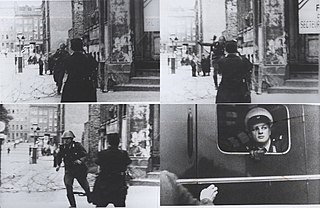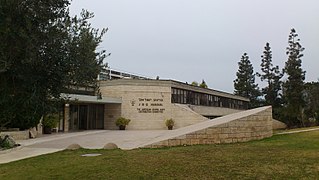The United Nations High Commissioner for Refugees (UNHCR) is a United Nations agency mandated to aid and protect refugees, forcibly displaced communities, and stateless people, and to assist in their voluntary repatriation, local integration or resettlement to a third country. It is headquartered in Geneva, Switzerland, with over 18,879 staff working in 138 countries as of 2020.

A refugee, conventionally speaking, is a person who has lost the protection of their country of origin and who cannot or is unwilling to return there due to well-founded fear of persecution. Such a person may be called an asylum seeker until granted refugee status by the contracting state or the United Nations High Commissioner for Refugees (UNHCR) if they formally make a claim for asylum.

The United States Refugee Act of 1980 is an amendment to the earlier Immigration and Nationality Act of 1965 and the Migration and Refugee Assistance Act of 1962, and was created to provide a permanent and systematic procedure for the admission to the United States of refugees of special humanitarian concern to the U.S., and to provide comprehensive and uniform provisions for the effective resettlement and absorption of those refugees who are admitted. The act was completed on March 3, 1980, was signed by President Jimmy Carter on March 17, 1980, and became effective on April 1, 1980. This was the first comprehensive amendment of U.S. general immigration laws designed to face up to the realities of modern refugee situations by stating a clear-cut national policy and providing a flexible mechanism to meet the rapidly shifting developments of today's world policy. The main objectives of the act were to create a new, American definition of refugee based on the one created at the 1951 UN Convention and 1967 Protocol on the Status of Refugees; raise the limitation from 17,400 to 50,000 refugees admitted each fiscal year; provide emergency procedures for when that number exceeds 50,000; require annual consultation between Congress and the President on refugee admissions; and establish the Office of U.S. Coordinator for Refugee Affairs and the Office of Refugee Resettlement. Most importantly, it established explicit procedures on how to deal with refugees in the U.S. by creating a uniform and effective resettlement and absorption policy.

The International Rescue Committee (IRC) is a global humanitarian aid, relief, and development nongovernmental organization. Founded in 1933 as the International Relief Association, at the request of Albert Einstein, and changing its name in 1942 after amalgamating with the similar Emergency Rescue Committee, the IRC provides emergency aid and long-term assistance to refugees and those displaced by war, persecution, or natural disaster. The IRC is currently working in about 40 countries and 26 U.S. cities where it resettles refugees and helps them become self-sufficient. It focuses mainly on health, education, economic wellbeing, power, and safety.

American Jewish Joint Distribution Committee, also known as Joint or JDC, is a Jewish relief organization based in New York City. Since 1914 the organisation has supported Jewish people living in Israel and throughout the world. The organization is active in more than 70 countries.
Church World Service (CWS) was founded in 1946 and is a cooperative ministry of 37 Christian denominations and communions, providing sustainable self-help, development, disaster relief, and refugee assistance around the world. The CWS mission is to eradicate hunger and poverty and to promote peace and justice at the national and international level through collaboration with partners abroad and in the US.

HIAS is a Jewish American nonprofit organization that provides humanitarian aid and assistance to refugees. It was established on November 27, 1881, originally to help the large number of Russian Jewish immigrants to the United States who had left Europe to escape antisemitic persecution and violence. In 1975, the State Department asked HIAS to aid in resettling 3,600 Vietnam refugees. Since that time, the organization continues to provide support for refugees of all nationalities, religions, and ethnic origins. The organization works with people whose lives and freedom are believed to be at risk due to war, persecution, or violence. HIAS has offices in the United States and across Latin America, Europe, Africa, and the Middle East. Since its inception, HIAS has helped resettle more than 4.5 million people.

The United States recognizes the right of asylum for individuals seeking protections from persecution, as specified by international and federal law. People who seek protection while outside the U.S. are termed refugees, while people who seek protection from inside the U.S. are termed asylum seekers. Those who are granted asylum are termed asylees.

The International Catholic Migration Commission (ICMC) is an international organization that serves and protects uprooted people, including migrants, refugees, and internally displaced people, regardless of faith, race, ethnicity or nationality. With staff and programs in over 40 countries, ICMC advocates for sustainable solutions and rights-based policies directly and through a worldwide network of 132 member organizations.
VOLAG, sometimes spelled Volag or VolAg, is an abbreviation for "Voluntary Agency". This term refers to any of the nine U.S. private agencies and one state agency that have cooperative agreements with the State Department to provide reception and placement services for refugees arriving in the United States. These agencies use funding from the State Department's Bureau of Population, Refugees, and Migration (PRM) along with self-generated resources to provide refugees with a range of services including sponsorship, initial housing, food and clothing, orientation and counseling. VOLAGs may also contract with the Office of Refugee Resettlement to provide job placement, English language training and other social services. Each of the ten voluntary agencies recognized by the federal government vary significantly in their history, experience, size, denominational affiliation, philosophy, primary clientele, administrative structure, resettlement capacity, and institutionalized resettlement. Of the ten U.S. resettlement agencies, all of them are religiously affiliated or faith-based with the exception of the International Rescue Committee. The tenth VOLAG was added fairly recently in November 2022, when Bethany Christian Services (BCS) was officially designated as its own resettlement agency by the PRM.

The Indochina Migration and Refugee Assistance Act, passed on May 23, 1975, under President Gerald Ford, was a response to the Fall of Saigon and the end of the Vietnam War. Under this act, approximately 130,000 refugees from South Vietnam, Laos and Cambodia were allowed to enter the United States under a special status, and the act allotted special relocation aid and financial assistance.
The Agency for New Americans (ANA) is the arm of the Episcopal Migration Ministries (EMM) in Boise, Idaho, which serves the primary and secondary enculturation needs of refugees. It is part of Jannus, Inc., formerly the Mountain States Group, and has operated under contract with, and under the aegis of, the VOLAG EMM in Boise since its establishment in October 1996.
The National Refugee Service (NRS) was a refugee aid organization founded in New York City on 15 May 1939 to assist refugees from Europe fleeing Nazi persecution. It represented a reorganization of a predecessor organization, the National Coordinating Committee for Aid to Refugees and Emigrants Coming from Germany (NCC), which had been in operation since 1934 as an umbrella organization of refugee aid agencies.p. 364-365 The National Refugee Service remained in existence until August 1946, when it merged with the Service for Foreign Born of the National Council of Jewish Women to form the new organization United Service for New Americans.
The Canadian Council for Refugees is a Montreal-based non-governmental organization that critiques the Government of Canada's public policy regarding refugee settlement and determination, and provides consultation to Canadian immigration authorities. According to the CCR, refugee services should focus on mental health.
The Office of Refugee Resettlement (ORR) is a program of the Administration for Children and Families, an office within the United States Department of Health and Human Services, created with the passing of the United States Refugee Act of 1980. The Office of Refugee Resettlement offers support for refugees seeking safe haven within the United States, including victims of human trafficking, those seeking asylum from persecution, survivors of torture and war, and unaccompanied alien children. The mission and purpose of the Office of Refugee Resettlement is to assist in the relocation process and provide needed services to individuals granted asylum within the United States.
A refugee crisis can refer to difficulties and dangerous situations in the reception of large groups of forcibly displaced persons. These could be either internally displaced, refugees, asylum seekers or any other huge groups of migrants.
Third country resettlement or refugee resettlement is, according to the UNHCR, one of three durable solutions for refugees who fled their home country. Resettled refugees have the right to reside long-term or permanent in the country of resettlement and may also have the right to become citizens of that country.
Congolese Australians are a people who were either born in the Democratic Republic of the Congo or the Republic of the Congo, or are of Congolese heritage, who have since settled in Australia. The Congolese Australian population has seen a marked increase since the end of the 20th century, growing from 21 individuals in 1996, to 5,522 by the 2016 Census. The influx of Congolese immigrants in the 1990s were initially the result of the First Congo War, a civil war in the country of Zaire, as well as the effects of the Rwandan genocide on the eastern border of the country, which created rebel militia groups, completely destabilizing state authority at the time. According to the 2016 Census, approximately 80% (3,228) of all Congolese-born Australians arrived in Australia between 2006 and 2016, this sudden increase in Congolese immigration was the result of a conflict between the Democratic Republic of the Congo's conflict against the Democratic Forces for the Liberation of Rwanda, an ongoing conflict beginning in 2004. The Congolese Australian population have settled evenly across the country's states and territories, with the largest populations being located in Queensland, Western Australia, and Victoria. Like most African Australians, it is not uncommon for Congolese Australians to experience racism, and research on their experience has been ongoing following their arrival in the early 2000s.
The city of Baltimore, Maryland includes a small Syrian population. The Syrian-American community is centered in East Baltimore. While Syrian-Americans have had a presence in Baltimore for over a century, most Syrians in Baltimore are recent immigrants and refugees who have fled the Syrian Civil War.






